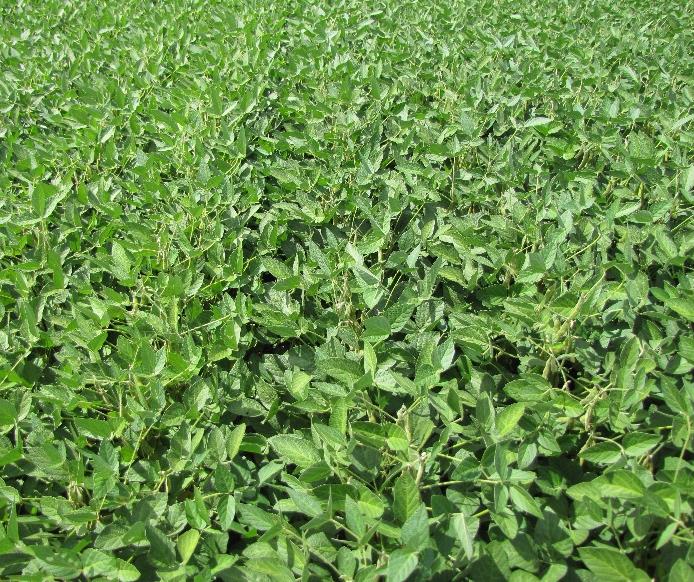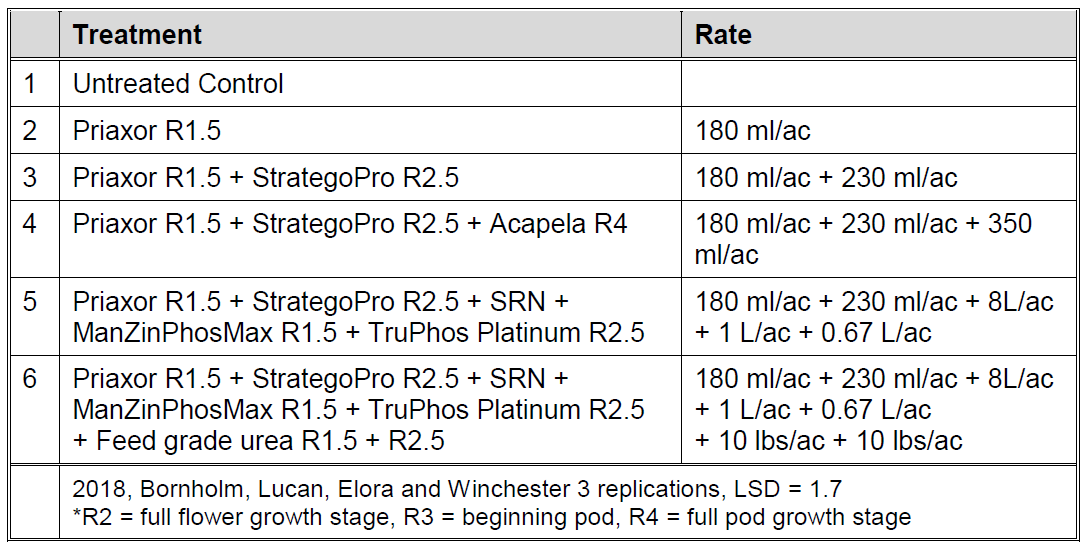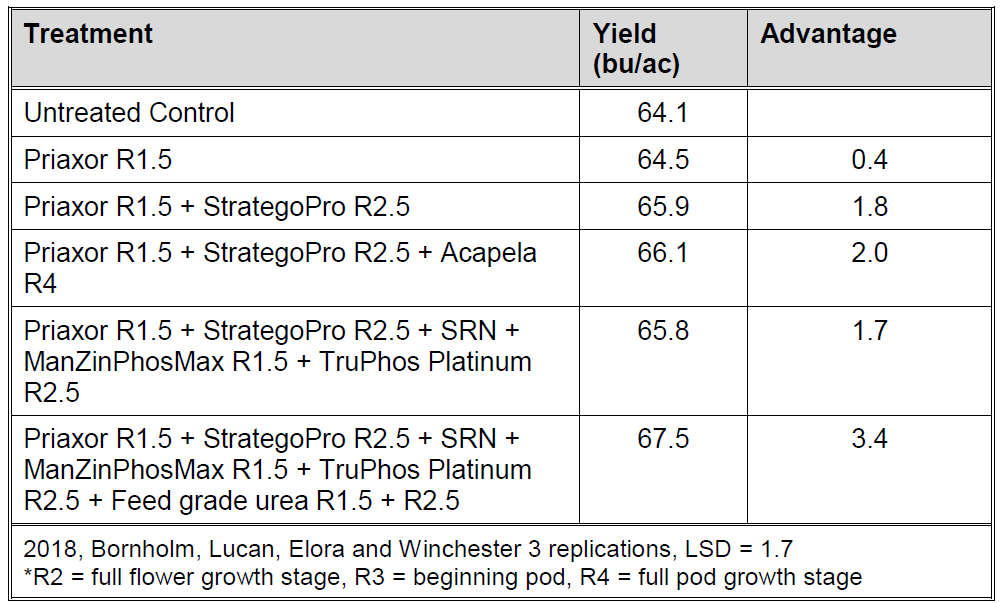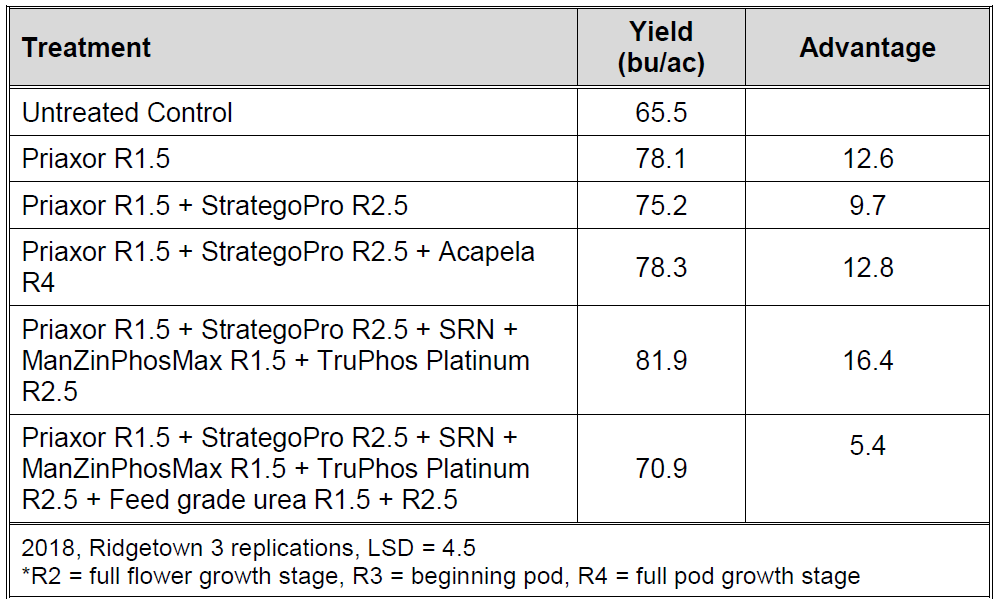Purpose
Foliar fungicides can be an important tool in the suppression of white mould and other foliar diseases. Several foliar fungicide trials have shown improved efficacy in the control of white mould when sprayed twice compared to one application. Since white mould infection occurs mainly during the flowing stage of the plant it makes logical sense that protecting more of the flowering period with a fungicide could provide additional benefits. Soybeans can flower for more than 5 weeks. If two applications are better than one is it possible that three applications are necessary for maximum yield response? Another question that has been raised recently is whether the addition of dissolved urea added as a tank mix could provide additional yield. High yielding soybeans require over 400 lbs/ac of nitrogen. The addition of nitrogen during late flowering or pod set could aid in achieving these high yields.
Picture 1: The application of nitrogen in 2018 resulted in more vigorous vegetative growth especially during the early part of the growing season. The right side of the picture above received urea during the R1.5 and R3.5 growth stages. The left side of the picture was untreated.

Methods
Six trials were conducted in 2018. Each had three replications. The locations of these trials were Bornholm, Lucan, Elora, Winchester, and Ridgetown. Two trials with difference varieties were tested at Bornholm.
The treatments applied in 2018 were:

Foliar application of fungicides was completed by a customized spray applicator at the various plant growth stages indicated in the treatment list. All treatments were replicated 3 times. 20 US gallons of water per acre were applied.
Results
White mould was not found at any of the trial locations in 2018 likely due to the extremely dry conditions during the first half of the growing season. Yield response trends were similar at 5 of the trial locations. See table #1. The sixth trial showed larger responses and is presented separately in table #2.
A positive yield response of 1.8 bu/ac was observed when Priaxor was applied at the R1.5 growth stage followed by a Stratego Pro application at the R2.5 growth stage. See Table #1. Three applications did not significantly increase yields over two applications. The addition of dissolved urea provided a small yield benefit.
A relatively large yield response was observed at the Ridgetown site with all the treatments. Yield benefits ranged from 5.4 bu/ac to 16.4 bu/ac. The reasons for the large yield response at Ridgetown is unknown since disease pressure was low. Variety response differences have been noted in past research so it is possible this variety (Pinnacle) was more responsive than the varieties used in the other trials. This trial was also seeded later (June 4th) so spray applications were conducted during much wetter conditions than the trials that showed small yield gains.
Summary
1. Large yield responses were observed when fungicides were applied at the Ridgetown site. Spraying two or even three applications did not significantly improve yields over just one application. The addition of nutrient additives including nitrogen showed mixed results and the addition of feed grade urea actually decreased yield in this trial. Since disease pressure was low these yield gains were not anticipated and support further investigation into the use of foliar fungicides on soybeans.
Table 1. Soybean Yield Response to Fungicide Application in 5 Trials

2. At the other 5 test locations two applications of a fungicide provided slightly higher yield compared to one application but the overall yield gains to fungicides were relatively small. Three applications provided no more benefit compared to two applications. Conditions were extremely dry during the first half of the reproductive stages at these sites.
Table 2. Soybean Yield Response to Fungicide Application at Ridgetown

Acknowledgements
We would like to thank Albert Tenuta for conducting the trial at Ridgetown College as well as Maizex Seeds, Dekalb, Syngenta, Dupont, Bayer, and BASF for materials provided for this project. This project was also supported by the GFO.
Project Contacts:
Horst Bohner (OMAFRA) horst.bohner@ontario.ca
